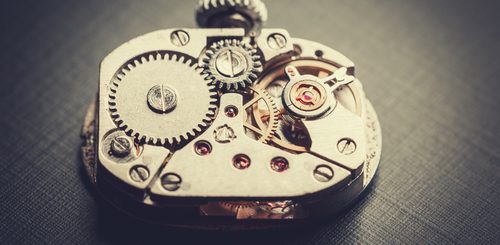Art Deco Elgin Legionnaire E-301 Watch Review

The Art Deco Elgin Legionnaire E-301 is an elegant watch with a case that is shaped like a cushion and a bezel that is engraved. It is one of the best examples of a stylish watch manufactured during the 1920s and 30s and is in crisp, almost mint condition, with virtually no brassing. It is 29 mm with 14 karat gold. The numerical dial is quite attractive, and this timepiece is powered through a 7-jewel movement that is manual.
Origin of Art Deco Watches
These watches incorporated the Art Deco style prior to the term being coined, which means that they were forerunners as opposed to followers. Art Deco is a form of visual art that was all the rage during the 1920s and 30s. It was even incorporated into architecture, with the most famous example being the Empire State Building, which for many years was the tallest building in the world. However, the style also extended to fashion and watches. The “Tank” by Cartier was the very first Art Deco watch, which was introduced in 1919. It featured a square dial which was distinct, with minimal decoration other than some columns or rows of Roman numerals on the perimeter which were blocky. Lugs near the case bottom and top provided the watch with a profile that was rectangular, which set the standard for other watches of the same period. These watches were popular among soldiers that fought in World War 1, and gradually garnered attention and praise for their minimalistic design approach. As a result, Art Deco watches were manufactured by other houses such as Bulova, Gruen, Omega and Rolex.
Elgin Legionnaire Design And Materials
The Elgin Legionnaire E-301 is sought after by collectors because aside from its materials, it utilizes all the best aspects of the Art Deco style. For instance, it is common for these watches to be manufactured with stainless steel, which when used in the case offer the watch an appearance which is machine aged. Natural materials are also frequently used, like lapis lazuli, but more common was silver or gold. These metals were preferred due to their beauty, longevity, and cost.
However, one thing that people note about this watch is that despite using 14 karat gold, it isn’t overly opulent, especially when compared to modern watches. The reason for this is because the watch was manufactured around the Great Depression. The economic hardships that were prevalent during this time meant that in order for watch manufacturers to be profitable, they had to produce high quality watches cost effectively, in a way that would make them attractive to consumers who were budget conscious. Although some watches of the time use gold and even platinum, it is done so sparingly.
Most of the watch dials were also two toned, which again was designed to enhance their appearance. A lot of these watches also used cases which were octagonal, with Roman styled chapter rings which have black enamel or matte silver. The crowns will sometimes be stylized.


